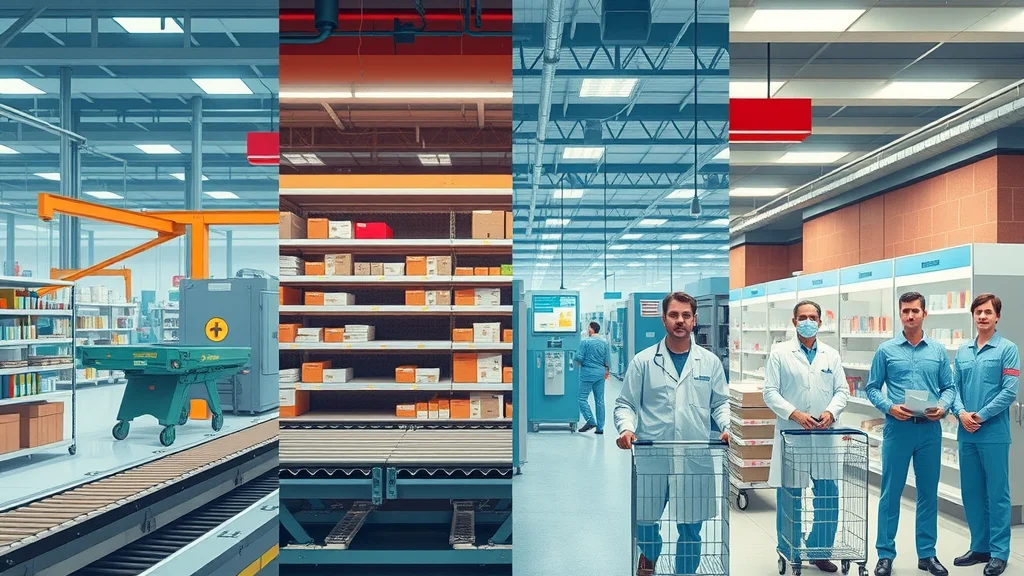Did you know that over $900 billion is lost annually due to the impact of supply chain disruptions around the world? This underappreciated crisis silently shapes our daily lives, from the availability of store products to the stability of entire economies. In today’s fast-paced global marketplace, understanding supply chain disruptions is no longer optional—it’s a vital skill for businesses and consumers alike. In this article, we’ll dive deep into why these disruptions happen, how they ripple through every industry, and what steps you can take to fight back and build a truly resilient supply chain.
A Startling Look at the Impact of Supply Chain Disruptions
"A single bottleneck in the supply chain can ripple across entire industries, causing economic shockwaves felt across the globe."

Supply Chain Facts: Understanding the Scope of Chain Disruptions
The impact of supply chain disruptions cannot be overstated. According to leading global supply chain management studies, billions are lost each year because of unforeseen chain shocks, whether due to natural disasters, raw material shortages, or large-scale geopolitical tensions. In fact, over 75% of companies reported experiencing at least one significant chain disruption in the past two years—a number that’s only expected to grow as global challenges persist. The effects of supply chain breakdowns go far beyond empty shelves; they produce ripple effects that jeopardize business continuity, lead times, and even the very flow of goods consumers and industries rely on.
Billions lost to supply chain disruptions in the global economy annually
Over 75% of companies have experienced chain disruption in the past two years
Natural disasters, pandemics, and raw material shortages are leading causes
These statistics highlight the vulnerability built into even the most advanced supply chains. As global trade grows more interconnected, the importance of supply chain resilience rises for every stakeholder.
What You'll Learn About the Impact of Supply Chain Disruptions

By reading this article, you’ll come away with actionable insights on:
What drives frequent supply chain disruptions
The real-world impacts of supply chain disruption on business and the economy
Actionable strategies to foster supply chain resilience
Expert opinions on the future of chain resilience
Each of these topics will enable you to see the full scale of the impact and guide your business or interest toward effective risk response. Let’s break down what chain disruptions really mean for you and your organization.
Defining the Impact of Supply Chain Disruptions: What Does It Really Mean?
The impact of supply chain disruptions is the total effect that sudden events—such as factory shutdowns, shipment delays, or geopolitical shocks—have on the interconnected systems that move goods from raw materials to consumers. It often manifests as extended lead times, increased costs, or outright shortages that affect everyone from producers to end users. A true disruption is more than an inconvenience; it’s a break in the reliable flow of goods and services that forms the backbone of the global economy. Understanding how these breakdowns occur is critical for businesses hoping to maintain supply and demand balance in the face of uncertainty.
Supply Chain Disruption vs. Chain Resilience: Key Differences
While supply chain disruption refers to unexpected interruptions in the normal operations of a supply network, chain resilience is about how quickly and effectively a system can bounce back. Chain resilience determines whether a business recovers or falters after disruption. It includes proactive planning, redundant suppliers, adaptable logistics, and real-time monitoring. Robust supply chain resilience transforms possible breakdowns into manageable bumps on the road, allowing a company to withstand or even leverage supply chain shocks to gain an edge.
Key Causes of Supply Chain Disruptions in the Global Economy
Disruptions in the supply chain rarely come from a single source. Understanding the primary triggers—ranging from natural disasters to global pandemics—allows organizations to prepare for and mitigate their effects. Here’s a look at the leading contributors to chain disruption in the modern era.
Geopolitical factors, such as shifting trade policies and tariffs, are increasingly shaping the landscape of global supply chains. For a closer look at how recent U.S. tariff strategies are influencing supply chain decisions and international trade, explore the evolving impact of Trump’s approach to tariffs and what it could mean for your business.
Natural Disasters and Raw Material Shortages

Natural disasters such as hurricanes, floods, earthquakes, and wildfires pose ongoing threats to global supply chains. When a major event hits a key supplier, the effects of supply chain disruption quickly reach production allocation, cause raw material scarcities, and may shutter entire industries until recovery is possible. The recent rise in extreme weather events has only intensified the unpredictability of the flow of goods, especially for supply chains reliant on a single region for raw materials.
These events do not happen in isolation: for example, a flood in Southeast Asia can simultaneously disrupt electronics manufacturing, delay agricultural exports, and affect raw materials needed for pharmaceutical production. A single supply chain shock can have a ripple effect that’s felt worldwide, increasing costs and impacting consumers and chain leaders alike.
Geopolitical Tensions and Trade Tariffs
Geopolitical tensions, including trade wars, shifting alliances, sanctions, and tariffs, are some of the most disruptive forces for today’s supply chains. Actions like sudden tariff hikes or export bans on critical components create chain shocks overnight. For manufacturers, this may mean quickly seeking new trade partners, renegotiating contracts, or facing significant delays. The semiconductor shortage of recent years—sparked in part by trade disagreements—demonstrates how the impact of supply chain disruptions triggered by politics goes far beyond political headlines, with real, everyday consequences ranging from delayed electronics to halted car production.
These disruptions can also reshape industry structures: companies might move supply chains closer to home (“reshoring”) or diversify regions to hedge their bets, introducing complexity and cost but building long-term resilience.
Pandemics and Other Unexpected Events
The COVID-19 pandemic revealed how a single global event can send even the most sophisticated global supply chain management systems into chaos. The result? Production delays, empty shelves, and mounting economic losses. In addition to pandemics, cyber-attacks, transportation strikes, and sudden regulatory changes can paralyze supply chains overnight. These events emphasize the need for a resilient supply chain that anticipates unexpected disruptions and quickly adapts—and why organizations cannot afford to overlook risk in their chain management strategies.
Chain leaders have realized that there is no universal playbook for such black swan events, but companies that invested in redundancy, analytics, and diversified sourcing weathered the crisis better than those who didn’t.
People Also Ask: The Impact of Supply Chain Disruptions
How do supply chain disruptions affect consumer prices?
Answer: Supply chain disruptions often cause a reduction in the availability of goods, which in turn leads to increased competition for limited stock. As lead times stretch and costs for manufacturers and distributors rise—from higher transportation expenses to pricier raw materials—these additional costs are frequently passed down the line to retailers and ultimately, to consumers. Studies show that even minor chain shocks in the global supply chain can result in significant inflationary pressure, especially for essential goods. Expert analysis confirms this ongoing challenge as a key reason for price spikes witnessed across various sectors after recent global events.
What industries are most vulnerable to supply chain disruptions?
Answer: Sectors heavily reliant on just-in-time manufacturing or single-sourced raw materials—such as automotive, electronics, healthcare, and retail—are the most susceptible to supply chain disruptions. For example, a chain disruption causing a semiconductor shortage can halt automotive and technology production simultaneously, while a pharmaceutical supply bottleneck can create critical shortages in healthcare. Industry experts stress that even industries with robust chain management protocols must now build flexible, resilient supply chains to withstand increasing global supply uncertainties.
How the Impact of Supply Chain Disruptions Spreads Across Industries

The true impact of supply chain disruptions isn’t confined to one sector. It cascades across industries, triggering secondary problems far beyond the original disruption point. For manufacturers, downtime means lost revenue and dissatisfied customers. Retailers end up with empty shelves, price hikes, and customer frustration. In technology, production delays slow the rollout of new products and harm competitive advantage. Perhaps most critically, healthcare faces shortages in essential supplies, risking lives on the frontlines. This interconnectedness shows why chain resilience is essential not just for individual businesses, but for the global economy.
Manufacturing: Downtime and lost revenue
Retail: Out-of-stock frustrations and rising costs
Technology: Delays in hardware rollouts
Healthcare: Shortages of life-saving equipment
A resilient supply chain is what stands between minor disruption and catastrophic breakdown—a fact underscored during the recent global supply chain shocks.
The Economic Magnitude of Supply Chain Disruption
Year |
Estimated Global Loss from Chain Disruptions (USD) |
Top Affected Sector |
|---|---|---|
2020 |
$800 Billion |
Manufacturing |
2021 |
$900 Billion |
Retail |
2022 |
$950 Billion |
Technology |
These figures paint a stark picture: the economic impact of supply chain disruptions is growing. The chain shocks of 2020-22 reinforced that disruption is not a rare event but a structural risk that spans industry and time. For business leaders, preparing for this “new normal” means prioritizing chain resilience or facing potentially existential losses.
Real-World Examples: Famous Supply Chain Disruptions and Their Consequences
How the 2021 Suez Canal Blockage Impacted Global Supply Chains

When a single container ship, the Ever Given, blocked the Suez Canal in March 2021, the impact of the supply chain disruption was felt worldwide. The canal—essential for global trade—became an unlikely flashpoint for a chain shock that delayed over 400 ships, froze billions of dollars in goods, and created a logistics traffic jam echoed by increased shipping costs and delayed supplies weeks afterward. This event underscored the vulnerability of critical global chokepoints and proved how quickly the ripple effect of supply chain disruptions can upend even carefully planned logistics networks.
COVID-19 Pandemic: Lasting Effects on Supply Chain Management
The COVID-19 pandemic wasn’t just a public health crisis—it was a massive supply chain shock with repercussions in every corner of the globe. From factories shuttered in Asia to empty retail shelves in North America and Europe, the effects of supply chain disruptions were immediate and profound. Businesses faced staff shortages, unpredictable lead times, and unprecedented demand fluctuations. As a result, many have moved beyond just-in-time production and toward contingency planning, digital transformation, and robust supply chain risk assessment, all in pursuit of chain resilience to withstand the next shock.
The pandemic also catalyzed investment in digital supply chain management tools, diversification of supplier bases, and increased attention to the vulnerabilities of global supply networks.
Watch a dynamic animated explainer visualizing how supply chain disruptions unfold, affecting shipments, inventory, and business responses—complete with infographics and professional motion graphics.
Long-Term Business Implications: Supply Chain Resilience and Chain Management
As the impact of supply chain disruptions becomes a defining theme of the 21st-century global economy, businesses are rethinking strategies, operations, and investments to foster resilience. The future belongs to those who balance efficiency with adaptability, utilizing both technology and human intelligence to ensure the flow of goods remains steady—even in a volatile world.
Adapting Supply Chain Strategies for Future Disruption

Building chain resilience requires more than just reaction—it means being prepared for the unexpected. Savvy chain leaders are investing in diversification, automation, and agile procurement models to keep the flow of goods moving no matter what happens next. Regular scenario planning, multi-region sourcing, and stronger relationships with logistics partners form the backbone of future-ready supply chain management.
Critically, businesses that invest now in adapting their strategies—especially by leveraging analytics for demand prediction and engaging with trusted supply partners—are most likely to survive and thrive in a world of constant chain shocks.
Role of Technology in Building a Resilient Supply Chain
Technology is rapidly transforming the fight against supply chain disruption. Digital platforms provide real-time end-to-end visibility, while data analytics enable predictive insights that help companies respond quickly to emerging threats. Blockchain ensures transparency and traceability, while automation accelerates warehousing and transportation efficiency. By embracing technological innovation, companies can build truly resilient supply chains, reducing lead times, preventing bottlenecks, and ensuring steady supply and demand alignment.
Investment in robust supply chain management software is no longer optional. The companies that emerge strongest from future disruptions will be those most committed to digital transformation and proactive risk management.
Expert Opinions: Insights on Navigating Supply Chain Disruptions
"Supply chain resilience is no longer optional—it's a competitive imperative." – Dr. Lisa Chang, Supply Chain Strategist
Expert consensus is clear: the impact of supply chain disruptions will continue to grow, and only those companies focused on resilient supply chain strategies and digital readiness will be able to withstand the next wave of global uncertainty.
Proactive Approaches: How to Fight Back Against Supply Chain Disruptions
Diversifying Your Supply Chains and Raw Material Sources

One of the most important steps toward supply chain resilience is diversifying both your supplier base and your raw material sources. Relying on single suppliers or limited regions exposes businesses to greater risk from chain disruptions. By cultivating multiple vendor relationships, expanding to new geographies, and actively monitoring geopolitical risk factors, companies increase their flexibility and reduce the impact of chain shocks on their operations.
This strategy is especially important for industries dependent on a narrow range of rare raw materials or regions. The resilience provided through diversification has proven invaluable during recent global supply chain shocks.
Establishing Supply Chain Resilience Protocols
Building resilience isn’t just about having more suppliers—it’s about instituting formal policies and playbooks to respond rapidly to supply chain disruptions. Protocols should include regular risk assessments, scenario-based training, backup logistics partners, and contractual safeguards. These steps ensure that when a chain shock strikes, teams can pivot quickly, minimizing downtime and preserving customer trust. A proactive culture of resilience is the hallmark of today’s top supply chain leaders.
Regular tabletop drills and robust contingency planning put you a step ahead of incoming disruptions, safeguarding your competitive position in the global economy.
Leveraging Data and Technology for Chain Resilience

Advanced analytics, AI-driven monitoring, and supply chain management dashboards can help scan for vulnerabilities, warn of impending problems, and allocate resources efficiently. Automated messaging tools speed up communication during emergencies, while smart contracts and blockchain platforms support transparency across every link in the chain. Data isn’t just a byproduct—it’s a shield against disruption. Companies mastering these tools build a truly resilient supply chain architecture.
The future of supply chain resilience is digital, with integrated systems providing the agility required to fight back effectively against disruptions, long before they escalate into chain shocks.
List: Top 10 Action Steps to Reduce the Impact of Supply Chain Disruptions

Map your entire supply chain for vulnerabilities
Diversify suppliers and regions
Invest in supply chain technology
Build up critical inventory
Establish transparent communication channels
Review and update contracts regularly
Develop contingency plans
Leverage predictive analytics
Engage in regular supply chain risk assessments
Foster collaborative relationships with partners
Executing these actions dramatically improves your ability to mitigate the impact of supply chain disruptions and ensures business continuity.
Explore how leaders around the globe are building chain resilience through innovation, digital strategies, and forward-thinking management in this concise animated feature.
FAQs on the Impact of Supply Chain Disruptions
What are common causes of supply chain disruptions?

Common causes include natural disasters (hurricanes, floods, earthquakes), geopolitical tensions (trade wars, export bans, tariffs), raw material shortages, pandemics, cyber-attacks, and transportation strikes. Each of these disrupts the flow of goods and threatens overall global supply chain stability. Recent years have shown that even unexpected events can trigger widespread chain shocks, forcing businesses to prioritize resilience in their day-to-day operations.
How can businesses improve their supply chain resilience?
Improving supply chain resilience starts with comprehensive risk mapping, investing in technology for real-time visibility, diversifying suppliers and regions, increasing inventory buffers, and creating well-rehearsed contingency plans. Additionally, robust communication and collaborative relationships with partners are essential for rapid, coordinated responses when disruptions occur.
How do supply chain disruptions affect the global economy?
Supply chain disruptions hinder the seamless movement of goods, increase production lead times, and escalate costs, which in turn slows down entire industries. As shortages and delays compound, inflation rises and economic growth stalls, showing how interconnected our global systems have become. Regular chain disruptions can erode consumer trust, shrink profit margins, and challenge the overall stability of the global economy.
Key Takeaways: Navigating the Impact of Supply Chain Disruptions
Preparation and resilience are key in minimizing economic fallout
Technology plays a critical role in supporting supply chain management
Collaboration and contingency planning are essential for all businesses
Stay Ahead: Be Proactive Against the Impact of Supply Chain Disruptions
Monitor global trade news for upcoming trends in supply chain disruption
Adapt your strategies as new threats emerge
Stay informed and connected to global supply chain updates
Conclusion: The Urgency of Preparing for Supply Chain Disruptions
"Disruption is the new normal. The impact of supply chain disruptions will define the winners and losers of tomorrow's global economy."
The time to prepare is now. Invest in resilience, act decisively, and your organization can weather any chain shock that comes its way.
Ready to Build a More Resilient Supply Chain?
Manufacturer don't miss out! Stay informed on global trade shifts—tariffs, reshoring, and supply chain updates could reshape your strategy. Subscribe to Global Trade News for latest updates. Call 203-271-7991 today.
As you continue to strengthen your supply chain strategies, it’s essential to stay informed about the broader forces shaping global trade. Understanding the nuances of international tariff policies and their ripple effects can help you anticipate challenges before they arise. For a deeper dive into how evolving trade strategies may influence your supply chain resilience and long-term planning, consider reading this comprehensive analysis of Trump’s tariff approach. Gaining insight into these macroeconomic shifts will empower you to make smarter, more agile decisions—ensuring your business remains competitive and prepared for whatever comes next.
 Add Row
Add Row  Add
Add 




Write A Comment